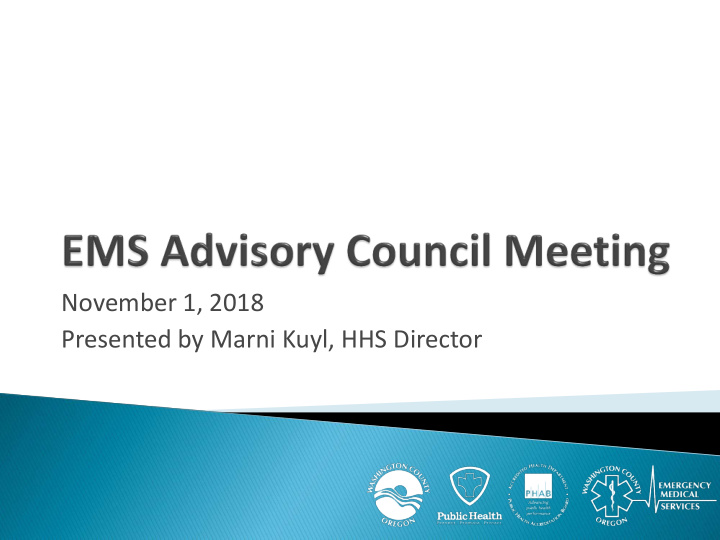



November 1, 2018 Presented by Marni Kuyl, HHS Director
Integrated EMS System based on a collaborative • public/private partnership Transparency and Accountability • Responsive • Fiscally Responsible • Clinical Excellence • Operational Effectiveness • Culture of Safety and Mindfulness •
Board of County Commissioners Washington County EMS EMS Advisory EMS QI Office Council Committee
Current financial model keeps transport costs low for patients Advisory Council able to make policy recommendations for systems improvements County and Franchisee have ability and willingness to amend contract Medical direction coordination provides uniform and aligned clinical and operational protocols Good response time and high cardiac resuscitations rates Excellent coordination and collaboration with all hospital systems Agreed upon foundational principles and prioritized system enhancements and improvements
No single regulatory oversight for all EMS providers; system coordination is voluntary (QI, training, etc.) Current financial model does not provide funding mechanism for system enhancements Systems improvements can be slow through a council model Lack of transparency for system issues Lack of quality systems performance metrics in place
Washington County • Statutory Authority; ASA Plan and County EMS Alliance (190) Administrative Rules • Oversight for • Administer and oversee ambulance implementation of provider contract integrated EMS plan and • Administrative home for Alliance (staffing budget support, budget, audit) • Coordinated medical • Formal annual ambulance rate approval oversight • Support central dispatch • Lead and coordinate system Membership: activities: QI, training, • Washington County • City of Hillsboro system complaint • Forest Grove, Cornelius, and Gaston investigation • Banks Fire District • Develop system policies • Tualatin Valley Fire & Rescue • Monitor and report system wide performance Private Provider • Rate analysis and Subcommittees: • Primary Transporter recommendation • Technical Advisory • • With WC develop new revenue Support and promote • Consumer/Community systems innovation model (i.e., return on revenue) • Support and promote new that supports systems and evolving revenue improvements/enhancement • Participant in EMS systems opportunities development through Alliance subcommittees
Governance agencies have shared authority for systems improvements and enhancements Governance agencies all contribute and participate in coordinated activities: QI, training, compliance metrics Increased systems transparency Smaller policy group to move policy agreement System complaints and issues focused on systems QI Supports strengths and assets of current system (e.g., coordinated medical direction, collaboration with hospitals)
Transition planning with EMS Council New financial model needs to fund resources needed for improvements and enhancements Potential rate implications Coordination between policy group and subcommittees will take time to develop Everyone needs to contribute something to achieve collaboration desired
Recommendation from EMS Advisory Council Engagement with Board of Commissioners Timeline Development Implementation Plan
Recommend
More recommend